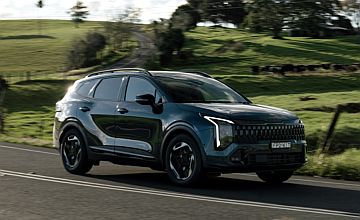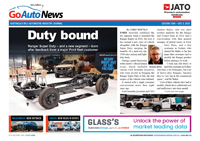Make / Model Search
OptionsCar reviews - Kia - SportageKia modelsOverviewWe like Crisper steering feel; new all-wheel hybrids; classier exterior and interior; increased equipment; impressively spacious; excellent handling Room for improvement 2.0 petrol is old and relatively thirsty; new eight-speed auto adds little to lacklustre 1.6 turbo; vinyl-trimmed SX+ doesn’t get seat cooling; no entry-level hybrid Best-selling Sportage SUV gets a worthwhile mid-life facelift, more hybrid variants16 Jun 2025 Overview
IT HAS arguably taken all five generations for the Kia Sportage to truly understand itself, but the proof is in its current popularity.
Offering a Medium SUV in two different wheelbases to suit market preferences, with a full suite of drivetrains, has elevated the fifth-gen Kia Sportage to become the Korean brand’s best-selling nameplate globally.
Sportage is Kia’s top dog in Australia, too, with a record 22,210 sales and a Top 10 finish for 2024, thanks to its long-wheelbase vastness, its broad variant range and the only remaining diesel in its class – with the most expensive GT-Line Diesel being the favourite variant for Australian buyers.
Which perhaps justifies the extra attention the GT-Line has been given in this mid-life facelift…
Changes are centred around a cleaner exterior design, a tidied-up interior with a new dashboard, upgraded infotainment, an Australian electric steering tune, Kia Connect app capability with over-the-air updates, a new eight-speed auto for the 1.6 turbo-petrol, two new AWD variants for the slightly uprated hybrid drivetrain, increased equipment across the board, and two new colours (Heritage Blue, Wolf Grey) – as detailed by GoAuto.
While Kia Australia says the MY25 Sportage may not eclipse its 2024 sales due to global demand, the mid-life facelift is a noticeably better car that’s also better value; and if/when the opportunity arises – we compete with the US for Sportage hybrid volume out of Korea – there’s also the likelihood of a base Sportage S hybrid joining the line-up.
Driving Impressions
Almost four years after it launched in Australia, the most significant update to the fifth-generation Sportage – at least from a driving perspective – is its belated Australian electric steering tune.
Due to pandemic-related development restraints, the car previously featured the global EPS tune, not a specific Australian one to match its Aussie suspension tuning. But that has now been rectified, and the engineering effort has definitely been worth it.
Despite having arguably too-thick steering-wheel spokes, the MY25 Sportage’s steering is less muddy than before, with a crisper, more consistent feel, and is more effortless in its movement while offering a sweeter union with the way the car handles.
It’s the missing link in the Sportage’s overall dynamic ability and makes this MY25 model one of the most polished and rewarding Medium SUVs to drive.
Of the four drivetrain variants, it’s the mildly uprated hybrid that stands tallest. Now offered with all-wheel drive as well as front-drive, the MY25 hybrid produces 173kW (up 4kW) and 367Nm (up 17Nm), though combined fuel consumption remains at 4.9L/100km for the FWD, with the AWD rated at 5.3L/100km.
Acceleration isn’t neck-snapping, but it is effortlessly capable and positioning the 37.5kg lithium-ion battery under the rear seat seems to make the nicely poised hybrid the sweetest-handling Sportage as well.
Only adverse conditions, or the promise of greater adhesion, would demand adopting AWD because the front-drive hybrid offers plenty of traction most of the time. Both hybrid variants, regardless of trim level, wear 18-inch wheels with 235/60R18 Nexen tyres.
The 137kW/416Nm 2.0-litre turbo-diesel AWD remains untouched, meaning a strong and acceptably refined engine, harnessed to an impressively capable eight-speed torque-converter automatic transmission for a 6.3L/100km combined fuel figure.
The carry-over 132kW/265Nm 1.6-litre turbo-petrol AWD also now features an eight-speed torque-converter automatic, replacing the previous seven-speed dual-clutch, which promises greater robustness, marginally quieter cruising and a bit more spirit off the line.
But the reality is little different for this relatively smooth but somewhat underwhelming drivetrain, a situation betrayed by its conservative outputs. It is not a performance option by any means. And its combined fuel figure is a mediocre 7.5L/100km – drinking 91RON regular unleaded, like all Sportage petrol powertrains.
To keep Sportage’s entry price low, and the fleets happy, the ageing 115kW/192Nm 2.0-litre multi-point-injected petrol remains alive (for now) – an engine that can trace its lineage back at least 15 years – tied to a reliably amenable six-speed automatic. The base six-speed manual has been discontinued for MY25.
Kia Australia admitted that the 2.0-litre’s “days are numbered globally”, though it remains a more driveable and responsive powertrain than the laggy, smaller-capacity turbo-petrols offered in rival Chinese SUVs – almost all of which are crying out for decent powertrain calibration.
The Sportage 2.0-litre, on the other hand, has been finessed to within an inch of its existence to make it viable, yet you can’t escape its below-average 8.1L/100km combined fuel number.
Cosmetically, the new Sportage’s refreshed face with vertical DRLs (instead of boomerang-shaped ones), and a more geometric treatment (including the futuristic new alloys) makes it look more modern and sophisticated, while closely tying the four-year-old Sportage to newer Kia models.
As for the equipment updates, offering push-button start, the Kia Connect app, a large 12.3-inch multimedia screen, wireless Apple CarPlay/Android Auto, a material-bound steering wheel, an emergency SOS button, and front and rear parking sensors on all variants delivers impressively solid value – one that favours engineering strength and integrity over gadget superficiality.
That said, the biggest-selling GT-Line flagship gains arguably the most kit, with four-cube projector LED headlights, dynamic welcome lighting, wireless smartphone mirroring, a head-up display, heated steering wheel, and highway driving assist via the safety electronics.
It still gets faux-leather upholstery, though at least it feels quite supple, and the front seats get cooling – unlike the similarly trimmed SX+ below it. Based on standard equipment and drivetrain availability, the best-value option appears to be the SX Hybrid ($46,450 FWD, $49,450 AWD) – and it also has the biggest boot (586 litres) because the hybrids feature a space-saver spare, not a full-size alloy.
What all MY25 Sportages continue to share is vast interior space with excellent vision, and really impressive ride quality that is supple but disciplined – clearly differentiating the locally-tuned Kia from its below-par Chinese contemporaries.
So, while some of the Kia’s rather irritating active-safety systems also need to be disabled (as in rival Chinese SUVs), the Sportage’s primary safety in terms of dynamic excellence and powertrain effectiveness remains leagues ahead.  Read more10th of June 2025  Entry-level Kia Sportage hybrid likelyKia says 2.0L petrol Sportage 'days are numbered’, making way for base model hybrid2nd of June 2025  Kia Sportage updated for MY26Eight-speed auto features as standard alongside refreshed looks and convenience17th of April 2025  Kia prices Tasman ute from $42,99024-variant Kia Tasman range offered in 4x2 and 4x4 format, range tops out at $74,990 |
OptionsClick to share
|



 Alfa Romeo
Alfa Romeo Abarth
Abarth Audi
Audi Aston Martin
Aston Martin BMW
BMW Bentley
Bentley Ferrari
Ferrari Chevrolet
Chevrolet Ford
Ford Fiat
Fiat GWM
GWM Foton
Foton Hyundai
Hyundai Honda
Honda Jaguar
Jaguar Isuzu
Isuzu Kia
Kia Jeep
Jeep Land Rover
Land Rover Lamborghini
Lamborghini Maserati
Maserati Lexus
Lexus McLaren
McLaren Mazda
Mazda Mercedes-Benz
Mercedes-Benz Mitsubishi
Mitsubishi Mini
Mini Peugeot
Peugeot Nissan
Nissan Ram
Ram Porsche
Porsche Rolls-Royce
Rolls-Royce Smart
Smart Skoda
Skoda Suzuki
Suzuki Subaru
Subaru Toyota
Toyota Tesla
Tesla Volvo
Volvo Zeekr
Zeekr







Facebook Twitter Instagram